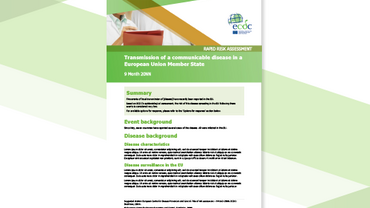Rapid Risk Assessment: Outbreak of Ebola virus disease in West Africa - 7th update, 17 October 2014
Following an increase in the number of cases of Ebola virus disease being recorded in West Africa, ECDC has updated its risk assessment and presents options for prevention and control of the disease for European citizens.
Executive Summary
Since December 2013, and as of 12 October 2014, 8 997 cases of EVD, including 4 493 deaths, have been reported by the World Health Organization (WHO) in seven reporting countries (Guinea, Liberia, Nigeria, Senegal, Sierra Leone, Spain and the USA). One additional case was reported by the USA on 14 October in a second healthcare worker in Dallas, Texas, who tested positive for Ebola virus after having cared for the first case in the USA.
On 6 October, the Spanish authorities reported a confirmed case of Ebola virus disease (EVD) in a healthcare worker who cared for a patient with Ebola infection repatriated to Spain. The ongoing investigation in Spain is providing information to further understand how the infection was transmitted to this healthcare worker. There is currently no evidence indicating that the healthcare-associated transmission resulted from a change in the transmissibility of the virus. The current recommended infection control measures remain appropriate, if strictly applied. While additional cases among the contacts of the infected nurse cannot be excluded at this time, it is considered extremely unlikely that the event will result in significant spread in Spain.
The evolving epidemic of EVD over the last weeks increases the likelihood that EU residents and travellers to the EVD-affected countries will be exposed to infected or ill persons. The risk of infection for residents and visitors in the affected countries through exposure in the community is considered low if they adhere to the recommended precautions. Residents and visitors to the affected areas run a risk of exposure to EVD in healthcare facilities. The level of this risk is related to how well the infection control measures are being implemented in these settings and the nature of the care required.
As the epidemic is still evolving and more staff is deployed in the affected countries to support the epidemic control, the risk of importation of EVD cases to the EU is increasing. The risk of Ebola virus spreading from an EVD patient who arrives in the EU as result of a planned medical evacuation is considered to be low when appropriate measures are strictly adhered to, but cannot be excluded in exceptional circumstances. The transmission to a healthcare worker in Spain illustrates the connection between the epidemic in West Africa and the risk for the EU, and further stresses the need to control the epidemic in West Africa.
If a symptomatic case of EVD presents in a EU Member State, secondary transmission to caregivers in the family and in healthcare facilities cannot be excluded. This may happen in particular at an early stage of the disease, when patients are not yet very contagious but unprotected contacts are occurring, and at a late stage of the disease, after EVD is confirmed, when patients may experience very high viral loads while undergoing contamination-prone invasive procedure in intensive care units.





